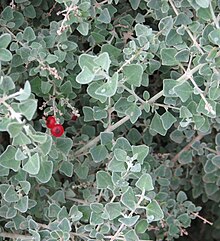Chenopodium curvispicatum
| Chenopodium curvispicatum | |
|---|---|

| |
| Scientific classification | |
| Kingdom: | Plantae |
| Clade: | Tracheophytes |
| Clade: | Angiosperms |
| Clade: | Eudicots |
| Order: | Caryophyllales |
| Family: | Amaranthaceae |
| Genus: | Chenopodium |
| Species: | C. curvispicatum
|
| Binomial name | |
| Chenopodium curvispicatum | |
Chenopodium curvispicatum is a species of plant in the family Amaranthaceae, endemic to Australia.[2]
It is a small Australian native shrub species of Chenopodium genus, which occurs in semi-arid and arid areas of Western Australia, South Australia, Victoria and New South Wales.[2] It is often referred to as cottony saltbush.[3]
Etymology and naming
[edit]The word curvispicatum is in reference to the shape of the panicles, which appear as drooping spikes.[4] Common names include cottony saltbush, and cottony goosefoot.[4] The species is often erroneously referred to in literature as Cheopodium gaudichaudianum, and also in hiberia as C. desertorum and Rghagodia spinescenus.

Description
[edit]Chenopodium curvispicatum grows to 1m high in the form of a straggly shrub, and features slender drooping branches with dense vesicular hairs.[4] The leaves are opposite or sub-opposite, with deltoid shaping profiles and are 1 to 1.5 cm long and wide, and are covered with white rounded hairs which appear as a silverly layer.[4] The flowers are either male or bisexual with pyramidal panicles 2–5 cm long.[4] The female flowers are found below the male, and the fruit is enveloping until mature when it opens to 5mm diameter and becoming red. The fruit is a berry which contains sap, and changes from red to orange as it dries.[4]
Taxonomy
[edit]Chenopodium curvispicatum is a member of the Caryophyllales order, within the Chenopodiaceae family.[3]
Ecology
[edit]Chenopodium curvispicatum is found in well drained calcareous limestone soils within semi-arid and sand plain woodlands.[5] Many of these areas have become degraded due to overgrazing, as well as being impacted by feral species including goats and rabbits.[6] Chenopodium family plants form key understorey components of plant communities. In these arid environments, understorey shrubs provide valuable habitat and resources for many species of herbs and grasses.[7]
A typical plant community type featuring common associations with Chenopodium curvispicatum is the Casuarina pauper/Alectryon oleifolius woodland and Eucalyptus shrublands in semi-arid areas within Nanya Station in western New South Wales.[8] These ecological communities form unique examples of intact vegetation communities rarely found in New South Wales.[8]
Reproduction/dispersal
[edit]The seeds are rounded at 1.5mm diameter, with a honeycomb matrix and are black in colour. The seeds disperse from fruiting flowers between March and September.[9]
References
[edit]- ^ "Chenopdium curvispicatum". Australian Plant Name Index (APNI), IBIS database. Centre for Plant Biodiversity Research, Australian Government, Canberra. Retrieved 16 February 2009.
- ^ a b "Chenopodium curvispicatum Paul G.Wilson". PlantNET - New South Wales Flora Online. Royal Botanic Gardens & Domain Trust, Sydney Australia. Retrieved 16 February 2009.
- ^ a b Australia, Atlas of Living. "Species: Chenopodium curvispicatum (Cottony Saltbush)". bie.ala.org.au. Retrieved 24 October 2023.
- ^ a b c d e f Western Australian Herbarium (1983). Nuytsia: journal of the Western Australian Herbarium. Vol. v.4:no.2 (1983). Perth, W.A: Department of Biodiversity, Conservation and Attractions.
- ^ BUREAU OF FLORA AND FAUNA (1984). Flora of Australia - Volume 4 Phytolaccaceae to Chenopodiaceae (PDF). Australian Government Publishing Service.
- ^ "Semi-arid Sand Plain Woodlands | NSW Environment, Energy and Science". www.environment.nsw.gov.au. Retrieved 24 October 2023.
- ^ The State of Victoria Department of Environment, Land, Water and Planning (2021). "Victorian semi-arid woodlands" (PDF).
{{cite web}}: CS1 maint: multiple names: authors list (link) - ^ a b Westbrooke, Martin E. (2007). "NANYA STATION, WESTERN NEW SOUTH WALES VEGETATION, FLORA AND FAUNA" (PDF). University of Ballarat.
- ^ "VicFlora: Chenopodium curvispicatum". vicflora.rbg.vic.gov.au. Retrieved 24 October 2023.
